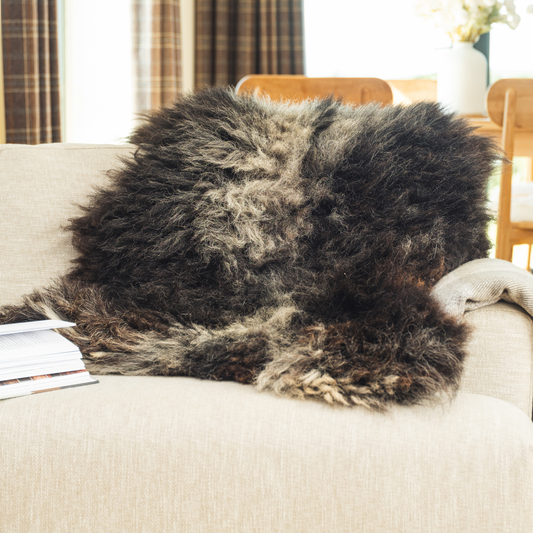Tanning is not a profession you can learn solely through sitting in a classroom. It's a craft that is developed and sharpened over the years through experimentation and experience.

Last week, we sat down with our tanners, Pete and Becky, and grilled them about the art of tanning, how they got into the job and how they have been honing their craft.
How did you become tanners?
Pete: I applied for the job, quite straightforward really.
Becky: Me too!
Pete: Although usually, unless your family owns a tannery, it is unlikely to be a standard career choice.
Who taught you about tanning?
Pete: Clive (Hartwell, who founded Skyeskyns) taught me then I taught Becky. We also both did the Northampton College tanning qualification, which is very technical and scientific as opposed to practical. I did my course with Jess (Hartwell, Clive's daughter) 10 years ago.
The course was very much focused on cowhide tanning as opposed to wool-on so the teachers had to get their head around our particular craft, such as the fact that sheepskin displaces a lot more water than leather on its own because of the wool (Ed: remember Archimedes? ;) )
Did you do the qualification straight away?
Pete: No, we both did a few months apprenticeship first, to get the basics. The first thing you do is usually fleshing.
Becky: There is so much to remember. Filling the tanks up, getting the right temperatures on the first washes, so we can get the fat out without ruining the wool and leather. The iron as well, as it can be quite temperamental.

Pete: Dealing with effluents as well (Ed: monitoring what is released into our settling tanks). Learnt so much from Clive. He was very open to new ideas, would listen and tell you straight whether it was a good idea or not. After a while, he took a back seat and left it to me.
Becky: Tanning is a job where you learn from your mistakes, there are no straight rules, every skin is different. Not something you can teach in the classroom, you have to do it.
Pete: Clive was mostly self-taught. He was encouraged by an ex-Navy colleague who had a leather business (and also had contacts in Norway sourcing our Norse fleeces). That got Clive interested in tanning. He learnt the rest on the job, employing John McLeod, the first Skyeskyns tanner. They both did the Northampton course many years ago.
What do you love about tanning?
Becky: It's a job you either really like or it's not for you. There is nothing quite like it. Pete and I are forever exchanging ideas and messages, in and out of work, on how to improve the process, particularly as we are working on changing our main tanning method. We exchange photos and update each other on what progress has been made, and lovely skins we see.
I love that we can see the whole process through from the raw skin to a really nice product.

Pete: we are quite lucky here because we get to do the whole process from start to finish, like the old way when the craftsman would do the whole thing. Larger tanneries can't do that, the work is broken down into stages. It's very satisfying to be in charge of the whole process.
We also don't want it to become a dying craft. It's great that we have open doors to the tannery, to show the public what we do; most tanneries do everything behind closed doors.
This is all about keeping the craft alive. We are using a product that is going to get thrown away. All we are doing really is stopping the skin from wasting away. We are not making sheepskins, they are made by nature and enhanced by Skyeskyns! It's good to keep the tradition going, keep Clive's passion alive.
You both have flocks of sheep on your respective crofts. Does it help with understanding tanning?
Becky: Sheep rearing is an advantage in this job as we understand how wool works, how new wool growth comes through and when. The older the sheep, the worse the wool, the fattier the leather.
(Ed: Becky breeds Shetlands and Jacobs which her mum turns into beautiful crafted pieces).

What part of the job do you like least and best?
Becky: Fleshing. It's hard work but very satisfying to go from a raw skin to a nice clean piece.
Pete: I don't much like pulling skins out of the tanning bath: it's very heavy work and can be quite cramped (Ed: with water retention, a skin can easily weigh 15 kilos). I really like fleshing too. I love most of it!
If you want to find out more about the tannery, you can visit us in Waternish on Skye year round.


